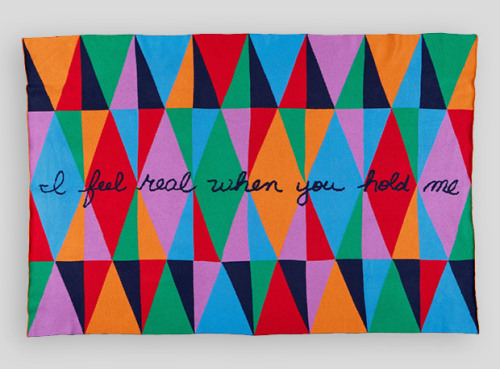

By Melissa Smith
Everything about the Venice Biennale feels big–monumental even. It is easily the most talked-about exhibition of contemporary art in the world. Jeffrey Gibson, 51, a member of the Mississippi Band of Choctaw Indians and an artist of Cherokee descent, is the first Indigenous artist to represent the United States with a solo exhibition. He plans to unveil new sculpture, painting and multimedia work at his pavilion, as well as a site-specific installation in the courtyard.
To help fund the project, Portland Art Museum and SITE Santa Fe have partnered with Sotheby’s and Sharon Coplan Hurowitz to publish a series of limited-edition cashmere blankets featuring Gibson’s design. Beginning today, an exclusive release of 60 blankets will be offered to the public on Sotheby’s Marketplace.
When I spoke with Gibson – and when he was photographed at his studio in Hudson, NY – the artist had just received a prototype of the design, which differs in color from the final result. The finished blankets, produced by SAVED NY, are on view at Sotheby’s booth at the IFPDA Fine Art Print Fair, 16-18 February 2024. “Jeffrey Gibson is an important member of the printmaking community,” says Jenny Gibbs, Executive Director of the IFPDA. “This year marks the return of the IFPDA to our first home, the Park Avenue Armory, and we were thrilled when Jeffrey was announced as the artist representing the US Pavilion for the 2024 Venice Biennale.” The energy that Gibson has put into the artwork, pouring over each element, shows that while he can certainly work big, some of his most exciting pieces are also the most intimate.
What are the origins of the blanket design?
The blanket design actually grew out of a flag that I designed for a performance in 2021, commissioned by the Aspen Art Museum. I’ve made flags before; the earliest one I can remember goes back to around 2010. Flags, for me, represent the idea of taking up space, in the model of nationhood. Different kinds of subcultures have created their own flags as ways of identifying themselves. And then the text reads: “I feel real when you hold me.” It is in my handwriting, and I decided to layer it on top of the flag. It’s just my thinking about blankets and wrapping things, but also my relationship both to people and objects.
How would you describe your use of color in the design?
I grew up with a lot of people criticizing my use of color, saying that I was using too much color. But ultimately, probably in my 30s, I just kept having this impulse to use color – in the way that hasn't left. It’s just with me. So I started following my intuitive use of color. And it was coming from a place where I was looking at a lot of Native American and Indigenous artifacts, but also regalia being made by contemporary powwow dancers. Their use of color is really the inspiration for me. When you go to a powwow, you see this whole spectrum, all the way up into fluorescence. I can see now how sensitive I am to color. So even if I'm working on a palette of six colors, it’s all about how they sit next to each other. When it comes to how color works with text, sometimes I want the background to sit on the same plane as the text. Other times, I want the text to be able to get lost and camouflaged. So now I have real strategies in the way that I use color.
How do the motifs relate to the ones you have used in the past?
In a lot of Indigenous pattern and design, they used specific color to convey a specific individual or a tribal community. So they’re not without content. In my case, I started paying attention to what I was returning to again and again, which is this grid of geometry–so working with horizontals and verticals. At this point, the basic grid of triangles can do a lot, and it seems to be my return to home base. And I start tweaking from there.
What is the significance of textiles in your practice?
I arrived at fiber and textiles in a way where I was more interested in narrative. My grandmothers made clothes for themselves, made dolls growing up or they made jewelry. They gave us quilts. When I was thinking about “how to refer to my heritage,” it was less about fiber and textiles and more about that object.
Photo: Jeffrey Gibson, I FEEL REAL WHEN YOU HOLD ME, 2024.